Processing of Agricultural Products and Food
Freshwater Fish Series Products Extraction Project of Baicheng City
1 Introduction to the Project
1.1 Project background
1.1.1 Product introduction
The protein amino acid extracted from freshwater fish has the high nutritional value and biological activity, and is widely used in fields such as food, medicine, and feed.
Freshwater fish meal has the characteristics of high protein and high fat, and is widely used in aquaculture, especially in aquaculture.
Freshwater fish oil is a type of fat extracted from the fat of freshwater fish, which has high nutritional value. Freshwater fish oil is rich in unsaturated fatty acids, which have many benefits for human health, such as reducing blood lipids and preventing cardiovascular diseases. Freshwater fish oil can be used as edible oil or as a health supplement.
Freshwater fish collagen is a protein extracted from the skin, bones, and other parts of freshwater fish. Collagen has excellent moisturizing, anti wrinkle, and firming effects on the skin, making it a holy product for beauty and skincare. Freshwater fish collagen can be used as a food additive and added to beverages, yogurt, and other products.
This project relies on the abundant freshwater fish resources in Zhenlai County, mainly for deep processing and extraction of freshwater fish. The extracted products include protein amino acids, fish meal, fish oil, and collagen.
1.1.2 Market prospect
(1) Current situation of the domestic freshwater aquaculture industry
Compared with terrestrial animals, freshwater fish have relatively higher protein content and lower fat content. They also contain rich nutrients such as unsaturated fatty acids, vitamins, minerals, etc., which have the effects of brain health, anti-aging, anti-cancer and other nutritional benefits. They are a high-quality food source for improving dietary nutrition and maintaining body health.
China is one of the countries with the largest inland water area in the world. There are many rivers, lakes, reservoirs, ponds and other freshwater areas, which provide unique conditions for freshwater fish breeding. China is one of the countries with the largest freshwater aquaculture water surface in the world, and the production of freshwater aquatic products also ranks first in the world. In recent years, China’s freshwater aquaculture industry has developed rapidly. There are about 26000 known species of fish in the world, including over 8600 species of freshwater fish. There are nearly 3000 species of fish in China, including over 1000 species of freshwater fish.
Freshwater fishing is an important component of China’s fisheries industry. Prior to 2018, the output value of China's freshwater fishing industry showed an upward trend. Due to the implementation of fishing bans in the Haihe River, Liaohe River, Songhua River and other river basins in China since 2018, the output value of China’s freshwater fishing industry has significantly decreased. By 2023, the output value of China’s freshwater fishing industry will have been 27.565 billion yuan, a year-on-year decrease of 0.49%.
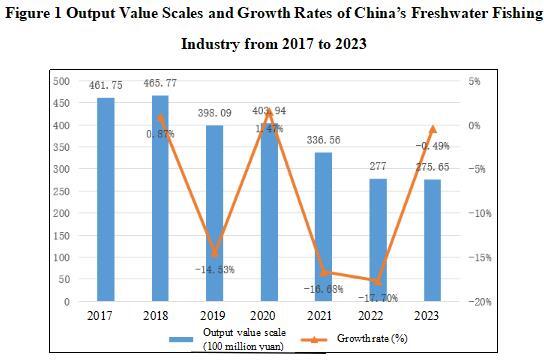
Faced with the challenge of declining production year by year, China is actively promoting the transformation and upgrading of freshwater fishing industry, and vigorously developing ecological fisheries. This includes implementing a fishing ban system, optimizing and improving resource conservation measures for the fishing industry, and promoting the coordinated development of freshwater fishing and aquaculture.
In recent years, with food safety and healthy eating becoming a hot topic of concern, residents’ demand for fresh, healthy, and high-quality aquatic products has continued to increase. Due to the limitation of natural aquatic resources, the production of fishing industry is limited, so the consumption demand for aquatic products will rely more on artificial breeding. China’s aquaculture industry has taken a dominant position in fishery production, and the scale of aquatic product breeding has steadily increased. China’s freshwater aquaculture has grown from 29.0529 million tons in 2017 to 34.1401 million tons in 2023, with a year-on-year growth rate of 3.78%.
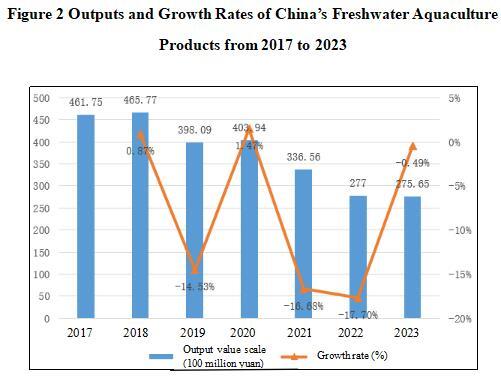
The aquatic product processing industry is a major part of the secondary fishery industry, which not only drives the growth of the fishery economy in terms of total volume, but also optimizes the fishery industry in terms of structure. Aquatic product processing includes the food processing industry that uses edible parts such as fish, shrimp, crab, shellfish, algae, etc. to produce frozen, pickled, dried, canned, and cooked foods, as well as the non food processing industry that uses low or inedible aquatic animals and plants and food processing waste as raw materials to process fish meal, fish oil, cod liver oil, hydrolyzed protein, fish glue, seaweed glue, iodine, chitin, etc.
From the perspective of per capita possession of aquatic products in China, as a major producer of aquatic products, the per capita possession of aquatic products has been continuously increasing in recent years. Specifically, in 2023, China’s per capita share of aquatic products was 50.48 kg, an increase of 1.85 kg over the previous year, or 3.80%, about twice the world average, and about 1/3 of the per capita consumption of animal protein.
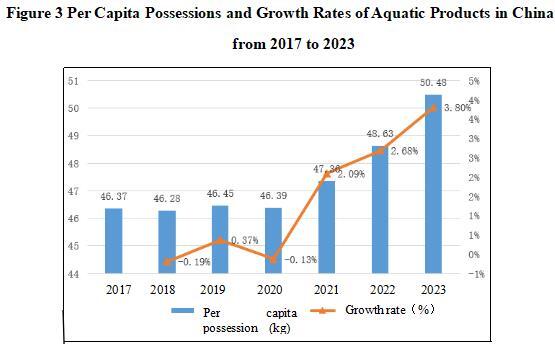
Aquatic product processing is not only a driving force for the aquatic industry, but also a leading and driving force for the development of the entire aquatic industry. It is a major area for enhancing the value chain of fisheries and extending the industrial chain, and a key link in the integrated development of the primary, secondary, and tertiary industries. From the perspective of aquatic product processing, with the continuous development of China’s aquatic product industry in recent years, the aquatic product processing industry in China has also developed rapidly. In recent years, the total amount of aquatic product processing in China has remained stable, with a slight increase in the proportion of freshwater processed products. Specifically, in 2022, the total processing capacity of freshwater aquatic products in China was 4.3864 million tons, a year-on-year increase of 5.38%; in 2023, the total processing capacity of freshwater aquatic products in China was 4.46 million tons, a year-on-year increase of 1.68%.
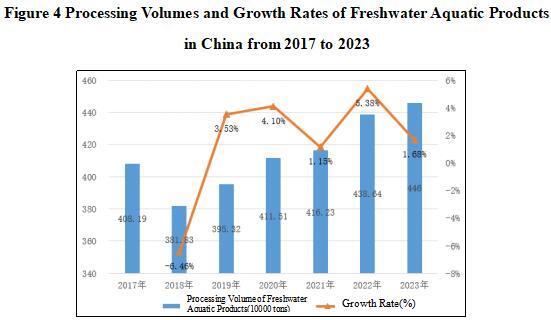
(2) Market analysis of the project
Freshwater fish is a common aquatic product that is highly favored by consumers due to its high protein content, low fat content, and rich nutritional value. With the sustained and healthy growth of China’s economy, the improvement of urban and rural residents’ income and urbanization process, the continuous improvement of people’s living standards, and the gradual improvement of dietary structure, the demand for aquatic products is increasing year by year, and the demand for high-quality and high priced aquatic products is also growing. The demand for freshwater fish market is increasing year by year.
Deep processing of freshwater fish, as an important part of the agricultural industry chain extension, not only profoundly affects the diversification and added value enhancement of agricultural development, but also promotes the efficient utilization of resources and sustainable development of the environment. This process not only enriches market supply and meets the diverse needs of consumers, but also drives the coordinated development of related industries, injecting new vitality into the transformation and upgrading of the agricultural economy. Therefore, vigorously developing the deep processing of freshwater fish can not only increase the consumption ratio of freshwater fish, optimize the dietary structure of urban and rural residents, but also improve the value-added utilization level of freshwater fish and promote the healthy and sustainable development of China’s freshwater fishery.
This project utilizes the abundant freshwater resources in Zhenlai County, mainly for deep processing and extraction of freshwater fish, including protein amino acids, fish meal, fish oil, and collagen extraction. The market prospect of the project construction is good.
1.1.3 Technical analysis
The project adopts the modern production technology and automated production line, with the mature production process and technology, and has the conditions for large-scale production.
Production process of protein amino acid: raw material preparation, hydrolysis reaction, cooling and pH adjustment, enzymatic hydrolysis reaction
Filtration and concentration, drying and packaging.
Fish meal production process: processing freshwater fish, extracting fish fin collagen, producing fish slurry, pressing and drying, grinding and mixing.
Fish oil production process: raw material processing, extraction, refining (decolorization, deodorization), packaging, and storage.
Collagen production process: raw material processing, extraction, purification and separation using composite enzymatic hydrolysis, drying and packaging.
1.1.4 Advantageous conditions of project construction
(1) Policy advantages
The Notice on Implementing Support Policies for Fishery Development and Promoting High-quality Fishery Development issued by the Ministry of Finance and the Ministry of Agriculture and Rural Affairs proposes to support the construction of facilities and equipment for initial processing and refrigeration preservation of aquatic products; promote the development of industries such as aquaculture and aquatic processing, optimize the structure of the fishery industry, and achieve the transformation and upgrading of the fishery industry.
The Notice on Promoting the Expansion of Production and Supply of Poultry and Aquatic Products through Multiple Measures, issued by the National Development and Reform Commission and the Ministry of Agriculture and Rural Affairs, proposes to adhere to the development direction of “large-scale breeding, centralized slaughtering, cold chain transportation, and fresh ice listing”, and to build supporting infrastructure such as centralized slaughtering points, cold chain logistics, and aquatic product processing, and continue to promote new production and consumption models. Guide development oriented and policy oriented financial institutions to increase their support for the aquatic product industry.
The Guiding Opinions on Promoting the Development of Large scale Ecological Fisheries issued by the Ministry of Agriculture and Rural Affairs, the Ministry of Ecology and Environment, and the Forestry and Grassland Bureau propose to develop deep processing of ecological aquatic products in areas near large water surfaces where conditions permit, cultivate and strengthen leading enterprises in the processing and circulation of aquatic products, develop convenient and convenient aquatic processing foods and tourism “souvenir” products with local characteristics, and give full play to the “continuous connection” role of the aquatic product processing industry.
The Opinions on Accelerating the High-quality Development of Mechanized Initial Processing of Agricultural Products issued by the Ministry of Agriculture and Rural Affairs propose to optimize the layout of initial processing of aquatic products, focus on the main production areas and key varieties, accelerate the filling of the short links in the initial processing chain of aquatic products, increase the processing ratio, and achieve loss reduction and efficiency improvement.
The Opinions of the General Office of the People’s Government of Jilin Province on Promoting High-quality Development of Fishery (JZBF [2021] No. 12) proposes that by 2025, the aquaculture area in the province will have reached 6 million mu, the output of aquatic products will exceed 250000 tons, and the total output value of fishery economy will have reached 26 billion yuan. It will actively develop aquatic product processing and leisure fisheries; develop the processing of bulk freshwater products such as silver carp and bighead carp, and support the development of segmented products, fish paste products, and other processed products in fishing areas such as Chagan Lake.
(2) Resource advantages
Zhenlai County is rich in water resources, with “one large river and three rivers” passing through the area. The Nenjiang River, the only river in northern China without pollutant emissions, flows 111.5 kilometers through Zhenlai County. Tao’er River, Hu’erda River, and Erlongtao River are distributed within the county. The natural abundant water resources and suitable climate provide a unique environment for the growth and reproduction of fish, and also create favorable conditions for promoting the high-quality development of fishery characteristic industries.
(3) Industrial advantages
Zhenlai County utilizes 40000 hectares of water surface for aquaculture, with an annual output of 1.2 million kilograms of 30 types of organic fresh fish and 35000 tons of aquatic products. It is the “largest county in Jilin Province’s aquatic industry” and organic fish has been rated as one of the “Top Ten Charming Agricultural Products in China”. Harnao specialties: three treasures of Nenjiang River, that is, paddy field, ear of wheat, small willow root; the types of fish include black carp, white fish (Juezuidaozi), silver carp, Chinese perch, bream, and variegated carp, Northem sheatfish, catfish, Shorthead catfish (Gayazi), flathead (Niuweiba). In 2023, the total output of aquatic products in Zhenlai County reached 27300 tons, and the total output value of fishery economy reached 500 million yuan. It has been awarded the national level healthy breeding demonstration county for 2021-2025 by the Ministry of Agriculture and Rural Affairs and is one of the first batch of named national level healthy breeding demonstration counties in China.
(4) Location advantages
Zhenlai County is located at the junction of the three major resource provinces (regions) of Heilongjiang, Jilin, and Inner Mongolia, and is known as the place “where rooster crowing can be heard in three provinces”. Within a radius of 200 kilometers, it is surrounded by five prefecture level cities (Songyuan, Baicheng, Qiqihar, Daqing, Ulanhot) and five regional airports, and is only 40 kilometers away from Baicheng Airport. There are two railways and two highways intersecting within the territory, making it an important “hub” city at the junction of Heilongjiang Province, Jilin Province, and Inner Mongolia. It is a must pass place for Inner Mongolia and Heilongjiang to enter the country, with convenient transportation and developed logistics, and has strong advantages in radiation and driving.
(5) Talent advantages
There are several research institutes in Baicheng City, including the Academy of Agricultural Sciences, the Academy of Forestry Sciences, the Agricultural Machinery Research Institute, the Livestock Research Institute, and the Research Institute. There are 40873 professional and technical personnel, including 6898 with senior professional titles, 18409 with intermediate professional titles, and 15566 with junior professional titles. Baicheng Academy of Agricultural Sciences is the only comprehensive agricultural research institution in the semi-arid special ecological zone of western Jilin Province. It leads the country in research on oats, sunflowers, miscellaneous grains and beans, and is the forefront and main research group for agricultural technology innovation and promotion in western Jilin Province.
1.2 Contents and scale of project construction
1.2.1 Product scale
In the year when the project reaches the production capacity, 100000 tons of freshwater fish will be processed annually, producing 20000 tons of protein amino acid, 200 tons of fish oil, 10000 tons of fish meal, and 30000 tons of collagen (including water).
1.2.2 Construction contents of the project
The project plans to cover an area of 60000 square meters and a building area of 50000 square meters. The main buildings to be constructed include the production and processing workshop, technical extraction laboratory, quality testing workshop, and extract storage warehouse. Four extraction production lines will be purchased, and supporting facilities such as water, electricity, heating, ground hardening, and greening will be built.
1.3 Total investment of the project and capital raising
1.3.1 Total investment of the project
The total investment of the project is 300 million yuan, including the construction investment of 240 million yuan and current funds of 60 million yuan.
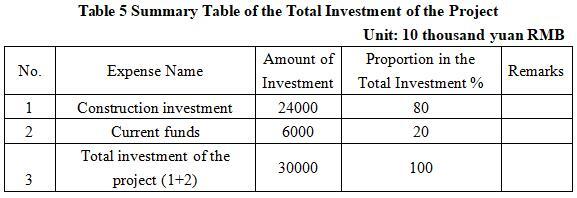
1.3.2 Capital raising
Self-financing by the enterprise
1.4 Financial analysis and social evaluation
1.4.1 Main financial indexes
After the project reaches the production capacity, its annual sales revenue will be 182 million yuan, its profit will be 60 million yuan, its investment payback period will be 7.0 years (after the tax, including the construction period of 2 years) and its return on investment will be 20.0%.
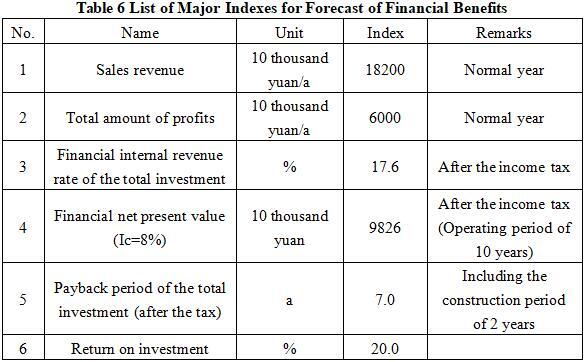
Note: “10 thousand yuan” in the table is in RMB.
1.4.2 Social evaluation
The construction of the project can not only improve the utilization rate of aquatic product resources, increase the added value of aquatic products, and bring more profit space to the aquatic industry, but also accommodate a large number of surplus labor in the local fishing area, which is conducive to social stability. The project construction drives the development of a number of related industries such as processing machinery and packaging materials, and has significant economic and social benefits.
1.5 Cooperative way
Sole proprietorship or joint venture
1.6 What to be invested by the foreign party
Funds, equipment or technology
1.7 Construction site of the project
Zhenlai County, Baicheng City
1.8 Progress of the project
The project proposal has been prepared.
2 Introduction to the Partner
2.1 Basic information
Name: Zhenlai Project Development Service Center
Address: 1777 Xinxing South Street, Zhenlai Town, Zhenlai County, Baicheng City
2.2 Overview
Zhenlai County is located in the northwest of Jilin Province, with a jurisdiction area of 4717 square kilometers. It is a large-scale commodity grain base and animal husbandry development demonstration base in China. Zhenlai County has obvious advantages in the location and transportation. With Zhenlai County as the center and a radius of 500 kilometers, it can comprehensively cover industrial cities and resource rich areas in Northeast China. The county has a total of 187300 hectares of arable land, 404.19 hectares of garden land, 40300 hectares of forest land, 41100 hectares of grassland, and 95200 hectares of water bodies and water conservancy facilities.
In 2023, the county’s GDP reached 9.48 billion yuan, a year-on-year increase of 6.6%; the fixed assets investment reached 2 billion yuan, up 23.6% year on year; the total output value of industrial enterprises above the designated size reached 2.7 billion yuan, a year-on-year increase of 9%; the added value of industrial enterprises above the designated size reached 780 million yuan, a year-on-year increase of 7%; the total retail sales of consumer goods reached 1.42 billion yuan, a year-on-year increase of 7%; the local level fiscal revenue reached 400 million yuan, a year-on-year increase of 20%; the per capita disposable income of urban residents increased by 8% year-on-year; the per capita disposable income of rural residents increased by 9% year-on-year.
2.3 Contact method
2.3.1 Contact method
Contact unit: Zhenlai Project Development Service Center
Contact person: Tian Tian
Tel: +86-15886168765
2.3.2 Contact method of the city (prefecture) where the project is located
Contact unit: Baicheng Bureau of Commerce
Contact person: Xu Zengchun
Tel: +86-436-3203010
+86-13894682986
E-mail: bcjhj07@126.com


